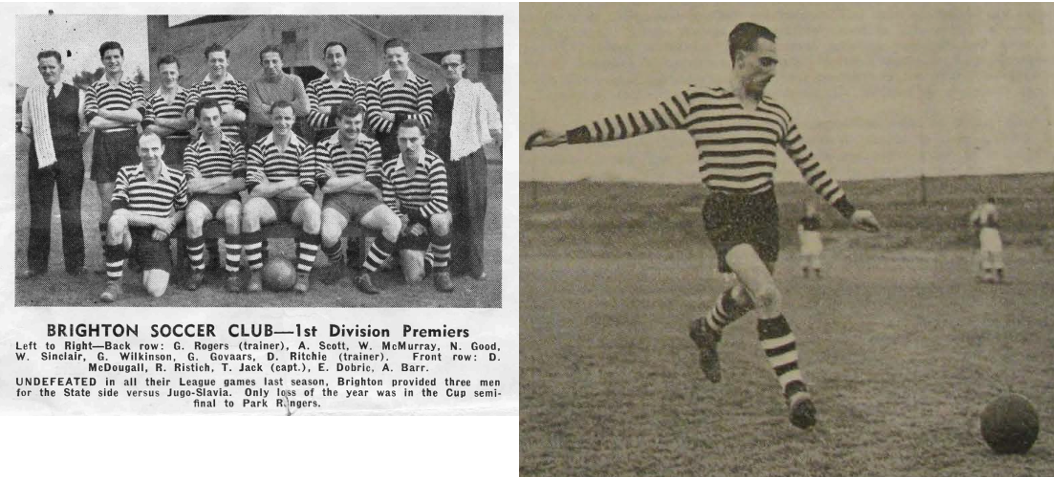In 1924, a special meeting was called at The Working Men’s Club, near the statue of former Premier of Victoria, Sir Thomas Bent. In that meeting, the Brighton Soccer Football Club was formed, and few would have predicted that over a century later, the club would ride the ups and downs to remain one of Victoria’s proudest football clubs.
The club’s first foray into football began at Hurlingham Park, a brisk 30-minute walk north of Dendy Park, where Brighton would ultimately build its base and lay the foundation as a junior development pathway for boys and girls in what would become the City of Bayside some 70 years later.
Initially wearing maroon jerseys with blue collars and white shorts, the club tasted success in their first season, finishing as runners-up in the Victorian Metropolitan Fourth Division to gain promotion to the state’s third tier. They benefited from the breakaway competition in 1927, winning the Sub-District League Championship and eventually gained promotion to the First Division proper with another runner-up finish, earning them a third promotion in their first six years as a club.

So began Brighton’s most successful period as a Senior Men’s football club, where owing for one season during the second World War, the club competed admirably in Victoria’s top-flight. Finishing a respectable third in 1932, Brighton’s return to competition in 1943 saw them in the Top 3 for the next seven seasons, the elusive Championship arriving in 1949, thanks in large part to an undefeated campaign, led by Australian internationals Tom Jack and Alec Barr, and Victorian representatives Duncan McDougall and Arthur Scott.
But if Brighton’s league form was impressive, their success in the Dockerty Cup was unparalleled. Their first win came in 1933 with a thrilling 4-3 win over St Kilda at the Exhibition Ground. 1937 delivered a win over Prahran City 3-1, while back-to-back victories followed in 1943 (a replay win over Moreland-Hakoah) and 1944, where they outclassed the RAAF team 3-0 at Toorak Park. Their fifth, and what ultimately proved their final Cup win came at Olympic Park in 1952, with a surprising 5-0 win over Juventus, themselves unbeaten all-season after claiming their first League Championship.

But as with several clubs immediately after the post-war period, Brighton didn’t have a hope of competing against the cosmopolitan stars from the European continent, who were arriving in Melbourne in their droves and forming clubs of their own. By the time the first Victorian State League had been run and won, Brighton finished dead last and were relegated for the first time in its history. Over the course of the next two decades, they would suffer that fate eight times more, with a promotion in 1969 and solitary Championship in 1974 (Metropolitan League 3) their only shining lights.
When the 1987 season had concluded, Brighton were entertaining the prospect of a season in the Men’s Provisional League Second Division, then the seventh tier of
Victorian football, but were saved by amalgamation with Prahran City, one of the Federation’s foundation clubs of 1908. The partnership saw them compete in the third tier and initial success came in the form of a runner-up finish in 1990. But hard times fell
once more and successive relegations saw the club in dire straits come 1995, when halfway through the season, the Men’s team folded and withdrew from the League, successive losses to Sunshine Heights (6-1) and Cranbourne Comets (7-1) signalling the death knell of a once proud club.
But where the Senior Men had failed miserably, the Junior Boys and Girls sathrived, and the club remained a going concern thanks in large part to its Junior Committee. Girls football was enjoying a boom in growth at the turn of the century and the Women’s program at Brighton had grown to such an extent that by 2007, the club fielded the largest participation base in the state, with well over 1,000 registered players gracing the fields of Dendy Park every other weekend. A credit to the program was the reformation of the Senior Men’s team the same year, some dozen years after its initial demise. True to that narrative, Brighton’s success has always been in its junior development. Their most notable graduate arrived in the form of Paul Trimboli, who began playing as a seven-year-old in 1976, but quickly established a reputation as an irresistible force within a few years. As reported in a late October edition of the iconic Soccer Action newspaper in 1981, Brighton’s focus on talent identification was paramount:
The club boasts many promising juniors. One of these is Paul Trimboli from the Under 12s. He already has outstanding vision for his age. Trimboli is a speedy striker with a nose for goal. Indeed, he’s a fine athlete in many sports. His future prospects are outstanding.
Trimboli would play 400+ matches in the National Soccer League and represent Australia on 46 occasions.
Recent success stories have come in the form of France-based Socceroo Denis Genreau and A-League Women’s star Grace Taranto. Genreau spent his formative years at the club before moving to Melbourne City's academy, where he excelled in both the NPL and A-League. Genreau signed for Toulouse in the French second tier in 2021, playing a key role in sealing promotion in his first season at the club. Taranto has been a mainstay in the NPLW, graduating from the NTC program after developing her game at Brighton. She has been a star with both Bulleen Lions and South Melbourne, while enjoying stints with Adelaide and Canberra United in the A-League Women's competition.
